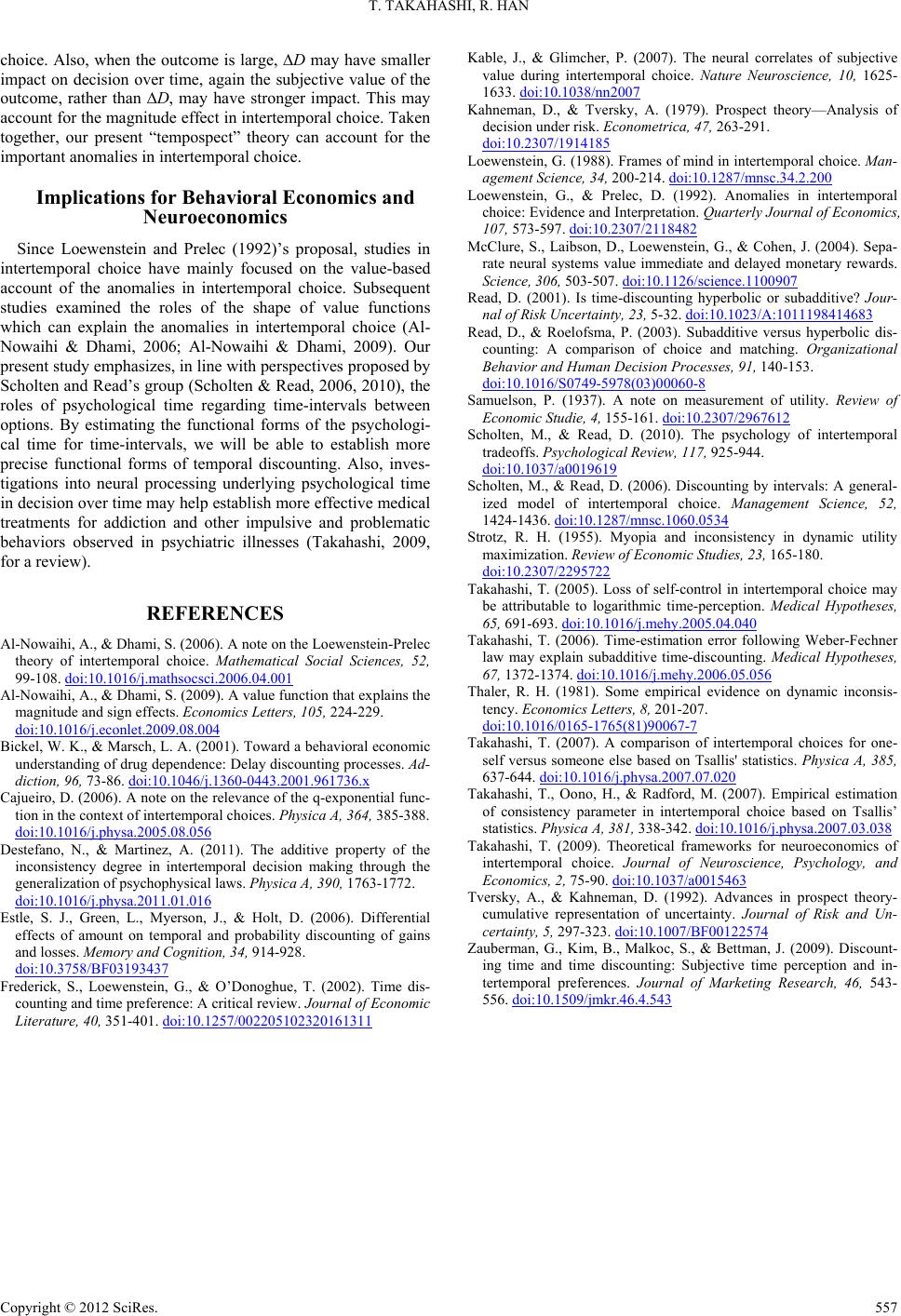
T. TAKAHASHI, R. HAN
Copyright © 2012 SciRes. 557
choice. Also, when the outcome is large, ∆D may have smaller
impact on decision over time, again the subjective value of the
outcome, rather than ∆D, may have stronger impact. This may
account for the magnitude effect in intertemporal choice. Taken
together, our present “tempospect” theory can account for the
important anomalies in intertemporal choice.
Implications for Behavioral Economics and
Neuroeconomics
Since Loewenstein and Prelec (1992)’s proposal, studies in
intertemporal choice have mainly focused on the value-based
account of the anomalies in intertemporal choice. Subsequent
studies examined the roles of the shape of value functions
which can explain the anomalies in intertemporal choice (Al-
Nowaihi & Dhami, 2006; Al-Nowaihi & Dhami, 2009). Our
present study emphasizes, in line with perspectives proposed by
Scholten and Read’s group (Scholten & Read, 2006, 2010), the
roles of psychological time regarding time-intervals between
options. By estimating the functional forms of the psychologi-
cal time for time-intervals, we will be able to establish more
precise functional forms of temporal discounting. Also, inves-
tigations into neural processing underlying psychological time
in decision over time may help establish more effective medical
treatments for addiction and other impulsive and problematic
behaviors observed in psychiatric illnesses (Takahashi, 2009,
for a review).
REFERENCES
Al-Nowaihi, A., & Dhami, S. (2006). A note on the Loewenstein-Prelec
theory of intertemporal choice. Mathematical Social Sciences, 52,
99-108. doi:10.1016/j.mathsocsci.2006.04.001
Al-Nowaihi, A., & Dhami, S. (2009). A value function that explains the
magnitude and sign effects. Economics Letters, 105, 224-229.
doi:10.1016/j.econlet.2009.08.004
Bickel, W. K., & Marsch, L. A. (2001). Toward a behavioral economic
understanding of drug dependence: Delay discounting processes. Ad-
diction, 96, 73-86. doi:10.1046/j.1360-0443.2001.961736.x
Cajueiro, D. (2006). A note on the relevance of the q-exponential func-
tion in the context of intertemporal choices. Physica A, 364, 385-388.
doi:10.1016/j.physa.2005.08.056
Destefano, N., & Martinez, A. (2011). The additive property of the
inconsistency degree in intertemporal decision making through the
generalization of psychophysical laws. Physica A, 390, 1763-1772.
doi:10.1016/j.physa.2011.01.016
Estle, S. J., Green, L., Myerson, J., & Holt, D. (2006). Differential
effects of amount on temporal and probability discounting of gains
and losses. Memory and Cognition, 34, 914-928.
doi:10.3758/BF03193437
Frederick, S., Loewenstein, G., & O’Donoghue, T. (2002). Time dis-
counting and time preference: A critical review. Journal of Economic
Literature, 40, 351-401. doi:10.1257/002205102320161311
Kable, J., & Glimcher, P. (2007). The neural correlates of subjective
value during intertemporal choice. Nature Neuroscience, 10, 1625-
1633. doi:10.1038/nn2007
Kahneman, D., & Tversky, A. (1979). Prospect theory—Analysis of
decision under risk. Econometrica, 47, 263-291.
doi:10.2307/1914185
Loewenstein, G. (1988). Frames of mind in intertemporal choice. Man-
agement Science, 34, 200-214. doi:10.1287/mnsc.34.2.200
Loewenstein, G., & Prelec, D. (1992). Anomalies in intertemporal
choice: Evidence and Interpretation. Quarterly Journal of Economics,
107, 573-597. doi:10.2307/2118482
McClure, S., Laibson, D., Loewenstein, G., & Cohen, J. (2004). Sepa-
rate neural systems value immediate and delayed monetary rewards.
Science, 306, 503-507. doi:10.1126/science.1100907
Read, D. (2001). Is time-discounting hyperbolic or subadditive? Jour-
nal of Risk Uncertainty, 23, 5-32. doi:10.1023/A:1011198414683
Read, D., & Roelofsma, P. (2003). Subadditive versus hyperbolic dis-
counting: A comparison of choice and matching. Organizational
Behavior and Human Decision Processes, 91, 140-153.
doi:10.1016/S0749-5978(03)00060-8
Samuelson, P. (1937). A note on measurement of utility. Review of
Economic Studie, 4, 155-161. doi:10.2307/2967612
Scholten, M., & Read, D. (2010). The psychology of intertemporal
tradeoffs. Psychological Review, 117, 925-944.
doi:10.1037/a0019619
Scholten, M., & Read, D. (2006). Discounting by intervals: A general-
ized model of intertemporal choice. Management Science, 52,
1424-1436. doi:10.1287/mnsc.1060.0534
Strotz, R. H. (1955). Myopia and inconsistency in dynamic utility
maximization. Review of Economic Studies, 23, 165-180.
doi:10.2307/2295722
Takahashi, T. (2005). Loss of self-control in intertemporal choice may
be attributable to logarithmic time-perception. Medical Hypotheses,
65, 691-693. doi:10.1016/j.mehy.2005.04.040
Takahashi, T. (2006). Time-estimation error following Weber-Fechner
law may explain subadditive time-discounting. Medical Hypotheses,
67, 1372-1374. doi:10.1016/j.mehy.2006.05.056
Thaler, R. H. (1981). Some empirical evidence on dynamic inconsis-
tency. Economics Letters, 8, 201-207.
doi:10.1016/0165-1765(81)90067-7
Takahashi, T. (2007). A comparison of intertemporal choices for one-
self versus someone else based on Tsallis' statistics. Physica A, 385,
637-644. doi:10.1016/j.physa.2007.07.020
Takahashi, T., Oono, H., & Radford, M. (2007). Empirical estimation
of consistency parameter in intertemporal choice based on Tsallis’
statistics. Physica A, 381, 338-342. doi:10.1016/j.physa.2007.03.038
Takahashi, T. (2009). Theoretical frameworks for neuroeconomics of
intertemporal choice. Journal of Neuroscience, Psychology, and
Economics, 2, 75-90. doi:10.1037/a0015463
Tversky, A., & Kahneman, D. (1992). Advances in prospect theory-
cumulative representation of uncertainty. Journal of Risk and Un-
certainty, 5, 297-323. doi:10.1007/BF00122574
Zauberman, G., Kim, B., Malkoc, S., & Bettman, J. (2009). Discount-
ing time and time discounting: Subjective time perception and in-
tertemporal preferences. Journal of Marketing Research, 46, 543-
556. doi:10.1509/jmkr.46.4.543